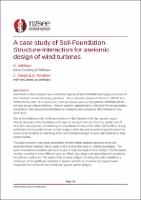A case study of Soil-Foundation-Structure-Interaction for aseismic design of wind turbines

Download
Date
2022-04-27Authors
Adhikari, Gopal
Keepa, Campbell
Novakov, Dejan
Metadata
Show full item recordAbstract
Wind farms in New Zealand have a combined capacity of about 690 MW and supply around 6% of New Zealand’s annual electricity generation. This is about the amount of electricity 300,000 kiwi homes use in a year. Wind farms don’t emit greenhouse gases as they generate electricity and are one way, we can reduce emissions. There is currently approximately 2,500 MW of wind generation consented in New Zealand and developers are exploring sites throughout New Zealand for new wind farms. One of the challenges with building wind farms in New Zealand is the high seismic hazard. Seismic demands on the foundations and towers can be significant and affect the capital costs of wind farm developments. Considering soil structure interaction effects during earthquakes and equivalent linear dynamic analysis of the structure-foundation-ground system has proven to be beneficial in optimizing mast and foundation designs in areas with moderate or high seismic hazard.
This paper presents a case study comparison between elastic response spectrum analysis and equivalent linear response history analysis of a wind turbine on shallow foundation, on a shallow soil site in an area of high seismicity in New Zealand. The foundations have been modelled in three different ways: as a fixed base, using a soil-spring bed and considering the soils as a continuum. The results of the response history analysis including the soils modelled as a continuum show significant reductions in seismic demands on the structure when compared to the results of traditional response spectra analysis ignoring soil structure interaction.
